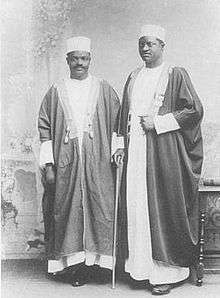Ham Mukasa

Ham Mukasa (1868–1956) was a page in the court of Mutesa I of Buganda (in present-day Uganda) and later secretary to Apolo Kagwa. He was fluent in both English and Swahili. He wrote one of the first glossaries of the Ganda language.[1]
Early life
Mukasa was the son of Makabugo Sensalire, a minor chief in Buddu (in present-day Masaka District).[2] He converted to Christianity at a young age.[1] He suffered serious injury in the 1886 massacre of Christians by Mwanga II.[3] As a result, he had a weak leg.[4] Around 1898, he married Наnnаh Wаwеmukо, the daughter of a former chief minister of Uganda.[2]
Journeys in England
Mukasa's book Uganda's Katikiro in England details his experiences on his journey from his homeland to the coronation of Edward VII of the United Kingdom, as secretary to Katikkiro (Prime Minister) Apolo Kagwa.[5] It was translated into English by Ernest Millar of the Church Mission Society in Uganda.[4] In London, Mukasa stayed at Alexandra Palace, and visited the London Hippodrome, attended a play in Drury Lane, and met with a variety of people such as writer Henry Morton Stanley and ex-governor of Uganda Harry Johnston.[6]
References
- Notes
- 1 2 Gikandi 2003
- 1 2 Pirouet 2004
- ↑ Gikandi 1998, p. 16
- 1 2 Green 1998, p. 19
- ↑ Mukasa, Ham (1904). Uganda’s Katikiro in England: Being the Official Account of His Visit to the Coronation of His Majesty Edward VII. London: Hutchinson & Company.
- ↑ Green 1998, p. 21
- Bibliography
- Gikandi, Simon (1998), "African subjects and the colonial project", in Gikandi, Simon; Mukasa, Ham, Uganda's Katikiro in England, Manchester University Press, ISBN 978-0-7190-5437-2
- Green, Jeffrey P. (1998), Black Edwardians: Black people in Britain, 1901-1914 (illustrated/annotated ed.), Taylor & Francis, ISBN 978-0-7146-4426-4
- Gikandi, Simon (2003), "Mukasa, Ham", Encyclopedia of African Literature, Taylor & Francis, pp. 347–348, ISBN 978-0-415-23019-3
- Pirouet, M. Louise; Harrison, B. (2004), "Mukasa, Ham (c.1871–1956)", Dictionary of National Biography, Oxford University Press, doi:10.1093/ref:odnb/75913